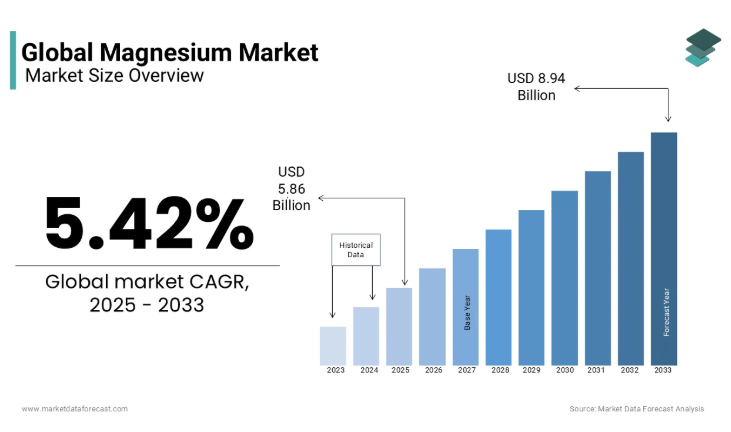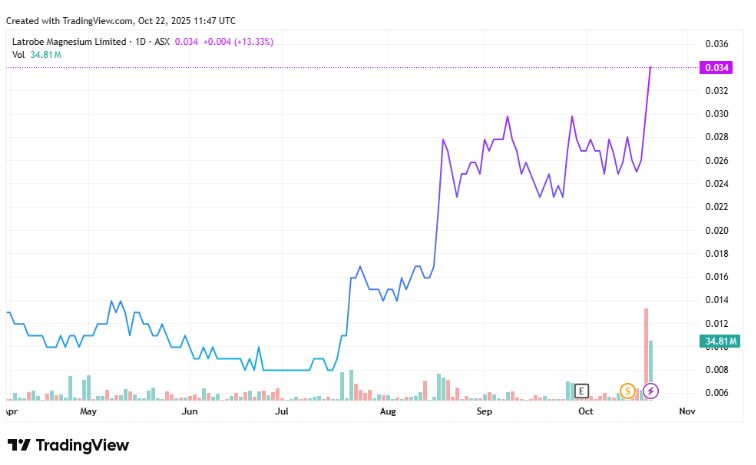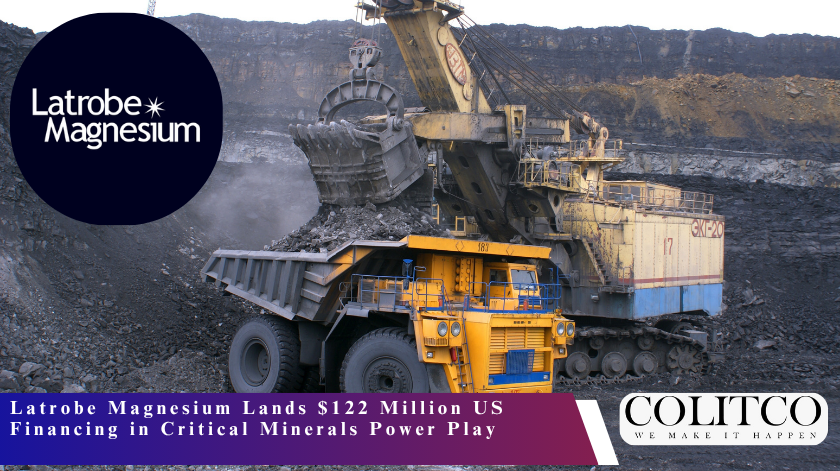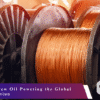Latrobe Magnesium has secured a major vote of confidence from Washington. The US Export-Import Bank committed up to $122 million in financing for the Australian company’s Stage 2 commercial magnesium plant. The deal signals America’s serious push to break free from China’s stranglehold on critical mineral supply chains.
The non-binding Letter of Interest arrived on October 20, 2025. It formed part of a landmark agreement between President Donald Trump and Prime Minister Anthony Albanese. The timing couldn’t be better for Latrobe or Australia’s critical minerals ambitions.
Washington Bets Big on Australian Magnesium
The financing package totals USD $122 million (AUD $200 million) spread over 15 years. It will fund construction of a 10,000 tonne per annum magnesium metal facility in Victoria’s coal power generation precinct.
Latrobe Managing Director David Paterson welcomed the support.
“We thank EXIM for supporting our project and our ability to supply magnesium to the United States within the short term. The United States does not currently have a local primary magnesium producer and LMG is ideally situated to fill this gap in the short and medium term,” Paterson said.
The commitment from EXIM Bank represents more than just money. It’s a strategic endorsement of Latrobe’s technology and Australia’s role as a trusted minerals partner. All of the Stage 2 plant’s magnesium metal output is allocated to US customers.
Advancing the @WhiteHouse America First vision, EXIM is driving $2.2B+ in LOIs with trusted partners – @ARULtd, @NorthernMins, @LMG_Magnesium, @SunRiseMetals, RZ Resources, VHM Limited & Graphinex. 🇺🇸🤝🇦🇺
Together with @POTUS, we’re fortifying U.S. supply chains, powering…
— Export-Import Bank of the United States (@EximBankUS) October 20, 2025
Part of Broader US-Australia Critical Minerals Framework
The Latrobe Magnesium US financing deal sits within a much larger picture. Trump and Albanese signed a landmark Critical Minerals Framework that includes over $2.2 billion in EXIM financing across seven letters of interest, potentially unlocking $5 billion in total investment.
Six other Australian companies received similar commitments:
- Arafura Rare Earths: up to $300 million for the Nolans project
- Northern Minerals: up to $230 million for Browns Range heavy rare earths
- Australian Strategic Materials: up to $600 million for Dubbo rare earths (March 2024)
- Sunrise Energy Metals: up to $67 million for Syerston scandium (September 2025)
- Victory Metals: $190 million for North Stanmore rare earths (April 2025)
- EQ Resources: up to $34 million for Mt Carbine tungsten (June 2025)
This coordinated approach shows how serious both governments are about supply chain security. Australia’s critical minerals strategy has positioned the nation as America’s go-to partner for escaping Chinese mineral dominance.
Why Magnesium Matters More Than Most Realise
Magnesium might not grab headlines like lithium or rare earths. But its strategic importance runs deep.

Global Magnesium Market Size
China controls approximately 85% of global magnesium production. The lightweight metal plays crucial roles in:
- Aerospace components (75% lighter than steel, 33% lighter than aluminium)
- Automotive lightweighting for fuel efficiency
- Electronics and semiconductors
- Defence applications including chemical agent alarms and radar systems
- Steel desulphurisation
The US Department of Energy’s 2023 Critical Materials Assessment identifies magnesium as a material with a high risk of supply disruption, emphasising the need for diversified sourcing and development of domestic production capabilities.
The US Defence Department’s interest makes perfect sense. As EXIM chairman John Jovanovic noted, the letter of interest to Latrobe reflects the bank’s commitment to advancing projects that strengthen US national security, enhance supply chain resilience, and revitalise domestic manufacturing.
Market Dynamics Favour Australian Producers
The magnesium market is experiencing structural changes that benefit producers outside China.
Global magnesium market value is projected to reach $8.94 billion by 2033 from $5.86 billion in 2025, growing at a CAGR of 5.42%. But the real story lies in where that production happens.
In the first quarter of 2022, China’s magnesium metal exports reached 69,182.65 tons, marking a 17.11% year-over-year increase. That concentration creates vulnerability for importing nations, especially during geopolitical tensions.
Enter Australia’s opportunity.
The Commonwealth government has backed multiple critical minerals initiatives including a $1.2 billion Strategic Reserve. These moves complement the US Inflation Reduction Act’s preference for minerals sourced from allied nations.
Investor Response: Share Price Surges
Markets rewarded Latrobe immediately after the EXIM announcement.

Latrobe Magnesium Share Price
Shares of Latrobe Magnesium rose as much as 46.2% to A$0.038, their highest level since October 10, 2024, set for strongest session since September 25.
The dramatic price move reflects how financing risk shapes small-cap miner valuations. A large, credible funding partner like EXIM reduces execution risk for a capital intensive project. For a small cap miner, that risk premium often drives share price more than anything else.
Project Timeline and Technical Advantages
Latrobe isn’t starting from scratch. The company already operates a demonstration plant producing magnesium oxide.
Key Project Milestones:
- Full demonstration plant opening: Q1 2026
- Stage 2 Commercial Plant completion: H2 2027
- Location: Victoria’s coal power generation precinct
- Annual capacity: 10,000 tonnes magnesium metal
The Victorian location provides infrastructure advantages. Proximity to existing power generation and industrial corridors reduces development risk and operating costs.
Latrobe’s proprietary hydrometallurgical extraction process offers environmental benefits over traditional methods. The technology extracts magnesium from waste feedstocks, positioning the company as a sustainable producer in an increasingly ESG-conscious market.
What Comes Next for Latrobe
The Letter of Interest is non-binding. That’s the critical caveat investors must remember.
The EXIM letter is not a final loan agreement, but it is a formal signal that the bank is prepared to finance a sizeable portion of the commercial plant if conditions are met.
Key Milestones to Watch:
- Conversion of LOI to signed financing agreement
- Feasibility and permitting updates
- Engineering progress at Stage 2 plant
- Additional funding sources to complement EXIM support
- Production timeline confirmations
Latrobe intends to complete the plant in the heart of Victoria’s coal power generation precinct in the second half of 2027. It is currently operating a demonstration plant, which is producing magnesium oxide, and intends to open the full plant in the first quarter of 2026.
Geopolitical Context: China Trade Tensions
The urgency behind these deals stems from real supply chain threats.
China recently imposed unprecedented export restrictions on rare earths. While magnesium wasn’t specifically targeted, the move reminded Western governments about concentrated supply vulnerabilities.
President Trump referenced these tensions directly, noting “They threatened us with rare earths, and I threatened them with tariffs, but I could also threaten them with many other things, like airplanes”.
Australia’s stability, regulatory transparency, and democratic governance make it the obvious alternative to Chinese supply. The US-Australia minerals partnership builds on decades of defence cooperation including the AUKUS submarine deal.
Industry Implications Beyond Latrobe
The EXIM commitment validates a broader thesis about critical minerals investment.
Several trends are converging:
- Government-backed financing de-risks early-stage projects
- Allied nations prioritising secure supply chains over lowest-cost sourcing
- ESG requirements favouring transparent producers
- Defence applications commanding premium pricing
Other Australian magnesium players should benefit from increased sector attention. The financing also sets precedents for how EXIM might structure deals with other critical mineral producers.
Risk Factors Investors Can’t Ignore
Despite the positive news, material risks remain.
Project Execution Risks:
- Construction cost inflation, commodity price swings for magnesium, and execution delays are real threats
- The financing is conditional on due diligence and final credit approval
- Technology scale-up from demonstration to commercial production
Market Risks:
- Magnesium price volatility could impact project economics
- Competition from other new sources of supply
- Potential Chinese response through pricing strategies
Regulatory and Permitting:
- Environmental approvals for the Victorian site
- Ongoing compliance with EXIM requirements
- State and federal government support maintenance
Critical minerals sector dynamics remain subject to policy changes in both Australia and the United States.
Also Read: Why Big Investors Are Standing By Pilbara Minerals Despite Brutal Year
The Bottom Line
Latrobe Magnesium’s $122 million EXIM Bank financing represents more than capital for one company. It signals a fundamental shift in how Western governments approach critical mineral security.
The deal demonstrates:
- US willingness to deploy significant capital for supply chain resilience
- Australia’s emergence as America’s preferred minerals partner
- Private sector execution backed by government strategic interest
- Growing recognition that not all commodities can be left to free market dynamics
For Latrobe, converting this Letter of Interest into a signed agreement will be the next critical milestone. Success would position the company as a cornerstone supplier to the US market at a time when alternatives to Chinese supply command premium value.
The share price surge shows market enthusiasm. But patient capital will wait for binding agreements, construction progress, and proof that the technology scales as promised.
One thing is certain: magnesium’s strategic importance has never been higher. And Latrobe just got the backing of the world’s most powerful economy to prove it can deliver.












